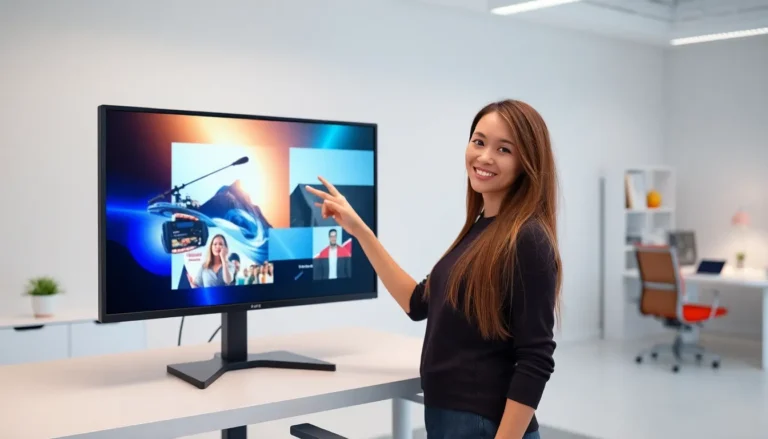Table of Contents
ToggleImagine a world where your computer and hardware devices speak the same language. Sounds like a sci-fi dream, right? Well, it’s not! With the right computer program, this seamless communication becomes a reality. Whether it’s your printer, scanner, or that mysterious gadget you bought during a late-night online shopping spree, these programs act as the translators, ensuring everything runs smoothly.
In a tech-savvy age, having devices that can’t communicate is like having a cat that thinks it’s a dog. It just doesn’t work! Understanding how these programs bridge the gap between software and hardware can transform your tech experience from frustrating to fantastic. Dive in to discover how these clever programs make your digital life easier, one device at a time.
Overview of Computer Programs and Hardware Communication
Computer programs serve as crucial intermediaries, facilitating communication between hardware devices and software applications. They translate commands and data from one format to another, ensuring that devices interpret instructions accurately. Each program corresponds to a specific device, like printers or scanners, enabling smooth interactions and efficient operations.
Drivers are essential elements of this communication process. They act as a bridge between an operating system and hardware components, allowing the system to understand and utilize the device effectively. Without proper drivers, a computer may fail to recognize or adequately interact with a hardware component.
Various programming languages contribute to the development of these communication programs. Languages such as C, C++, and Java often provide the frameworks required for creating software that interacts with hardware. Programmers utilize libraries and APIs, simplifying the interaction while ensuring devices function correctly.
Protocols form another foundational aspect of hardware communication. Communication protocols specify rules for data exchange. Common examples include USB, Bluetooth, and TCP/IP. Each protocol has unique characteristics suited for different types of devices and applications, affecting their performance and reliability.
Overall, the seamless collaboration between computer programs and hardware devices enhances user experiences. Users encounter fewer disruptions and increased functionality when devices communicate effectively. Thus, understanding how these programs operate contributes to optimizing technology’s role in everyday tasks.
Types of Communication Protocols

Communication protocols play a vital role in how computer programs interact with hardware devices. These protocols determine the rules for data exchange and are essential for ensuring efficiency and reliability.
Serial Communication
Serial communication transmits data one bit at a time. This method connects devices such as modems and microcontrollers over a single channel. Typically, systems like RS-232 define standards for serial communication, enabling straightforward point-to-point connections. Data transfer rates vary, often ranging from 300 bps to several megabits per second. Various applications use serial connections for their simplicity, with common uses including remote controls and GPS devices.
Parallel Communication
Parallel communication sends multiple bits simultaneously, utilizing multiple channels. Often, it connects devices like printers and internal components in computers. The IEEE 1284 standard facilitates this type of communication, improving speed and performance. Data transfer rates can reach up to 1.5 Mbps, making it suitable for applications requiring rapid data movement. Many older printers relied on parallel communication due to its speed compared to serial methods.
Wireless Communication
Wireless communication allows devices to connect without physical cables. Technologies such as Wi-Fi, Bluetooth, and Zigbee enable this form of communication, expanding device interoperability. Wi-Fi networks can transmit data at speeds over 1 Gbps, while Bluetooth typically operates at slower speeds, approximately 2 Mbps. Devices like smartphones and tablets commonly use wireless communication to enhance user convenience and mobility, making everyday interactions seamless and efficient.
Key Features of Effective Communication Programs
Effective communication programs excel in bridging the gap between hardware and software. They ensure interoperability, allowing diverse devices to work seamlessly together.
Compatibility with Various Devices
Compatibility ranks highly among communication programs’ critical features. These programs support a wide range of devices, including printers, scanners, and cameras. An extensive device list enhances user experience by eliminating connection issues. Programs written in languages like C, C++, and Java often incorporate various drivers that promote this compatibility. Strong adherence to established protocols facilitates successful connections across different platforms.
User-Friendly Interface
User-friendly interfaces simplify interactions, making technology accessible to all users. Intuitive design, easy navigation, and clear instructions enhance the overall experience. Clear labeling of functions allows users to understand the options quickly. Visual cues further guide users throughout the process. Support for multiple languages streamlines communication for diverse audiences. Overall, a well-designed interface fosters confidence and efficiency in device interactions.
Reliability and Speed
Reliability and speed are paramount for successful data transfers. Programs must consistently provide accurate responses to user inputs. Fast data exchange minimizes delays, ensuring smooth operation. Robust error handling capabilities enhance program reliability by preventing crashes. Proper optimization of communication protocols boosts performance, supporting high-speed data transmission. Users benefit from fewer disruptions and enhanced functionality during tasks.
Popular Computer Programs for Hardware Communication
Several computer programs excel in enabling hardware communication. Their capabilities streamline interactions between software and various devices.
Program A: Features and Advantages
Program A provides robust support for USB communication, making it ideal for connecting printers and external drives. User-friendly interfaces help beginners navigate settings effortlessly. Compatibility with a wide range of operating systems enhances its versatility. Moreover, the program includes built-in error detection, ensuring data integrity during transfers. Automatic updates maintain performance and security, keeping users up-to-date with the latest features. Users frequently appreciate the comprehensive documentation that facilitates quick troubleshooting.
Program B: Features and Advantages
Program B specializes in Bluetooth communication, perfect for connecting wireless peripherals like keyboards and mice. It offers seamless multi-device pairing, allowing users to switch connections without hassle. Strong encryption ensures data privacy during transmission, adding an extra layer of security. Efficient power management features prolong battery life, benefiting users with portable devices. Additionally, the program includes customizable settings for advanced users, enhancing personalization. Customers value the quick setup instructions, which promote immediate usability.
The ability of computer programs to facilitate communication with hardware devices is essential in today’s digital landscape. These programs act as vital intermediaries that enhance user experiences by ensuring smooth interactions between software and hardware. With the right drivers and communication protocols in place, devices can operate effectively and efficiently.
As technology continues to evolve, the importance of these communication programs will only grow. Users can expect improved functionality and reliability from their devices, thanks to advancements in programming languages and protocols. Ultimately, understanding and leveraging these tools will empower individuals to navigate their tech environments with greater ease and confidence.






